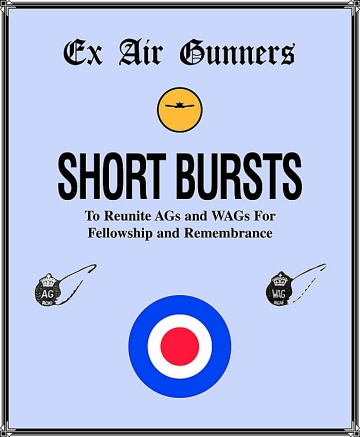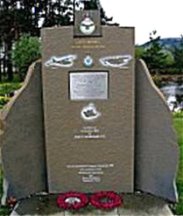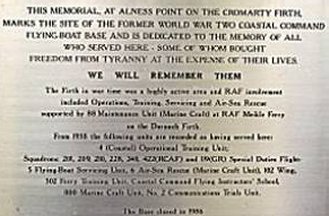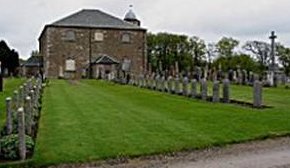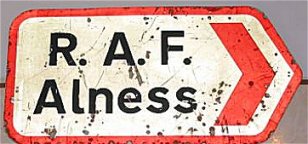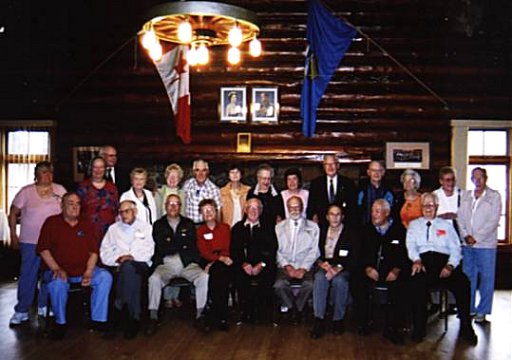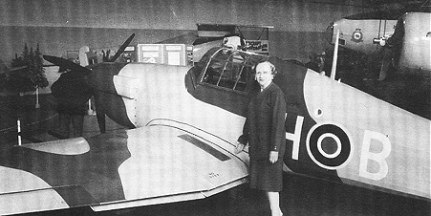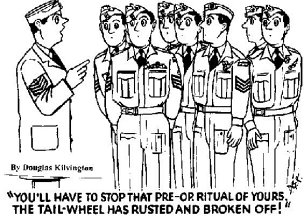.
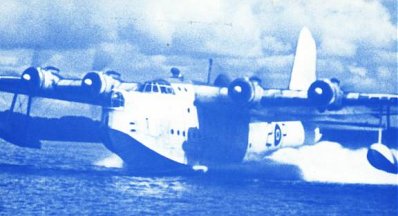
Sunderland taking off
By the start of the Second World War in September 1939
three squadrons had been equipped with the Sunderland. Seven hundred and
forty-nine Sunderlands were built, and they served throughout the war.
The final Coastal Command Sunderland operational mission was in June 1945
over four weeks after the German surrender. Long-range Sunderland operations
also took place overseas from bases in Africa and the Far East.
Post-war the type took part in the Berlin Airlift carrying
4920 tonnes (4847 tons) of freight. During the Korean War Sunderlands based
in Japan undertook nearly 900 operational sorties totalling over 13350
hours of flying. The Sunderland finally retired from RAF service in 1959
when the last aircraft were scrapped at RAF Seletar, Singapore.
The Sunderland's design was so good that it remained in
front line service for over twenty years. It was also the last flying-boat
operated by the Royal Air Force. The Sunderland was produced as a military
development of the 'C'-Class Empire flying-boat operated by Imperial Airways.
It entered service in June 1938 and was the first British flying boat to
have power-operated gun turrets as part of its defensive armament. This
strong protective armament resulted in the Germans giving it the nickname
'Flying Porcupine'.
Don Macfie WAG on 423 and 422 Sunderland Squadrons
Something inside me has been nagging for months to write
this little sad story. And now I have, I hope it goes away.
Harry Parliament had been a school teacher in Cannington,
Ontario, and must have been in his thirties, an old man to us 19 and 20
year old squirts. But Harry had the right education to become a good
Navigator at Oban Scotland. Harry’s countenance was plain. Back home in
“Sunny Slope” Ontario, my mother would have said, “plain homely,” with
his long face and jutting jaw.
Eventually it came to notice that Harry was escorting
a female Naval person, just as plain and homely as himself. Tall and angular,
straight lines, strolling arm in arm.
We finally got operational with 12 crews at Castle Archdale
in Northern Ireland, late fall 1942. By August 1943 we had all done many
long and tiring trips. In 1943 I was “joed” into Bishop’s crew in which
Harry was the Navigator for one patrol. Working across the isle from him,
over a long, rough night trip of 16 hours or more, I got to see how thorough
and accurate he was. In a wild North Atlantic gale, navigational
aids being wireless fixes from Group, and with rain pouring in from a leaking
astro hatch right over Harry’s navigation table, he brought us home right
on time.
In August 1943 both our crews were scheduled for a search
above 63 degrees North, close to Iceland and then land at Reykjavik. For
some reason our trips were switched and we went first leaving at 10:30
p.m. We put in a peaceful trip of 15 hours over calm seas.
Bishop’s crew followed the next morning at 0455 hours
to cover the same area. They found a fully surfaced “Milch Cow” submarine
(a refuelling vessel) on the surface. It was the one of two left in the
enemy’s fleet and it serviced 12 Atlantic submarines in the area.
Bishop’s crew attacked and the result was a destroyed
submarine, a downed aircraft, and a lot of airmen and sailors floating
around in a sea of burning fuel. A German started firing his luger
pistol and ‘Ginger’ Harcroft took a bullet between the eyes. Harry Parliament
was wounded and struggling in the water. The rest of the crew reported
that when they last saw Harry, he had a look of agony on that plain countenance
as he sank beneath the waves, never to re-surface.
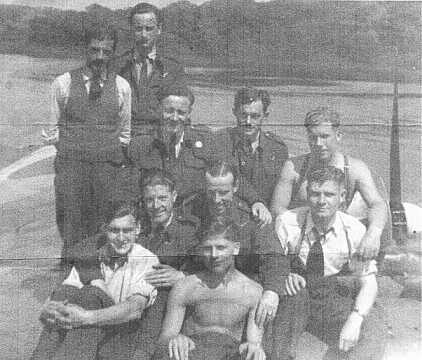
Bishop’s crew.
Front – Val Richard; Art Mountford
Second row – S. Gossop (KIA); Harry Parliament
(KIA); Wetlaufer;
Third row – Horseborough; Kelly (KIA);
Bishop;
Standing front – “Huck” Finn;
Extreme rear - “Ginger” Harcroft (KIA) - (Killed
in Action)
The British Destroyer Castleton picked up six survivors
of Bishop’s 10 man crew and fifty-eight survivors of the submarine crew.
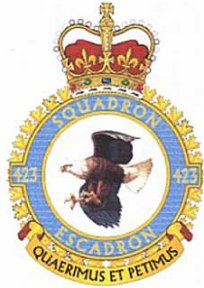
423 Squadron Crest
Nickname: Eagle
Motto: QUAERIMUS ET PETIMUS - "We search and strike"
Editor’s Note. CANADIAN SQUADRONS IN COASTAL COMMAND
by Andrew Hendrie reports this attack pg 77/78
ISBN 1-55 125 –038-1
Vanwell Publishing Limited
PO Box 2131
St. Catharines, ON L2R 7S2
Roll out of the Curtiss
Special Replica
July 09, 2006-07-20 Alberta Aviation Museum, Edmonton,
Alberta.
Submitted by Ted Hackett
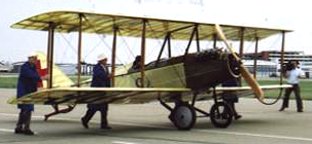
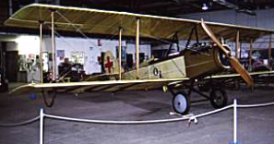 The first air mail delivery in Western Canada took place
on July 9, 1918, when Catherine Stinson flew her Curtiss Special from Calgary
to Edmonton with 259 pieces of mail. The flight took two hours and when
she landed in Edmonton she handed over the bag of mail to the Edmonton
Postmaster.
The first air mail delivery in Western Canada took place
on July 9, 1918, when Catherine Stinson flew her Curtiss Special from Calgary
to Edmonton with 259 pieces of mail. The flight took two hours and when
she landed in Edmonton she handed over the bag of mail to the Edmonton
Postmaster.
The Alberta Aviation Museum decided some years ago to
commence a restoration programme to bring the Curtiss Special back
to life. It soon became apparent that no remains of the original aircraft
or plans had survived. However, the Museum was undaunted and decided to
construct a full scale replica of the aircraft. The major details f the
aircraft were obtained from old photographs and parts from similar aircraft.
It proved to be one of the most challenging projects undertaken by the
Museum.
A more detailed account of the building of the replica
and photographs of it under construction, can be found in June 2006 Short
Bursts Page. (scroll down to archives)
On July 9, 2006, a re-enactment of that famous flight
took place when Audrey Kahovec, a pilot with the Edmonton Flying Club,
flew from Calgary to Edmonton carrying 259 pieces of mail. The envelopes
of the mail were designated and produced by the Western Chapter of the
Canadian Aerophilatelic Society.
When Audrey Kahovec landed she was driven to the Curtiss
Special replica. She climbed into the cockpit and the aircraft was pushed
to the reviewing stand where she handed the bag of mail to a representative
of Canada Post.
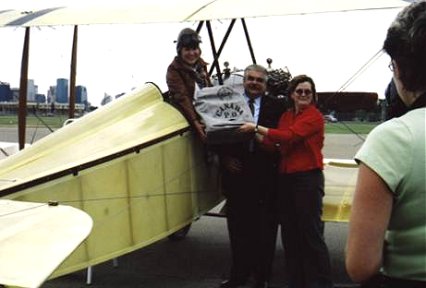
Audrey Kahovec delivering the mail
This beautiful restoration is the work of Lindsay Deeprose,
the Restoration Manager, and his skilled team of Gerry Blacklock, John
Burley, Arnold Dayman, Jean Philippe Dacaen, Bill Else, Jim Fearn, Garry
Fischer, Bill Gunn, Stan Larson, Denis Loiseau, Chuck MacLaren, Gordon
MacLaren, Roy Miller, and Paul Swanson.
Anyone coming to Edmonton should make a point of visiting
the Alberta Aviation Museum to see this work of art. While the Museum is
home to some great aircraft, this one for the moment, has to be the gem
of the collection.
CANADA’S BEST
KEPT SECRET OF WWII
The Armoured Train
by Ted Hackett
The Japanese attack on Pearl Harbour and the enemy’s
successes in the following weeks and months caused great concern on the
West Coat of Canada. Prince Rupert was now a strategic port, and embarkation
point for US Army Personnel and supplies destined for Alaska. The United
States had already built an installation and had several personnel stationed
at the port. The Canadian National Railway line that ran along the Skeena
river now became very important. At that time no highway ran to Prince
Rupert.
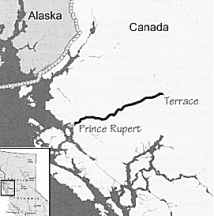
The defence of Prince Rupert was supported by seven coastal
batteries and, in 1942, by two railway guns supplied by the United States
Army.The RCAF 7 BR Squadron patrolled the area using Blackburn Shark aircraft
on floats. John Moyles was stationed there and hopefully he will write
an account of his adventures at that time.
In early 1942 it was decided to build an armoured train
to patrol the railway line between Prince Rupert and Terrace, B.C., a distance
of 95 miles. The train was assembled at the CNR Transconna Workshops in
Winnipeg, Manitoba and consisted of seven pieces of modified, armour plated,
rolling stock pulled by a steam locomotive. The locomotive was a CN class
H-10, number 1426 and 4-6-0 commonly called a “10 wheeler”. That last bit
of information is for any railroad buffs amongst our readers. There were
plans to replace the steam locomotive with a diesel electric and CN No.9000
was chosen, but by the time it was obtained through the US Navy the need
for the train was downgraded.
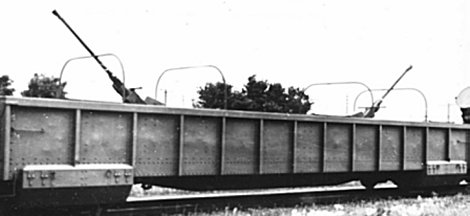
The train was manned by a company from the Winnipeg Grenadiers
and equipped with Bren Guns, 75mm and Bofor guns. The assigned task was
to patrol the Skeena river and engage any ships that attempted to sail
up the river and, perhaps land troops.
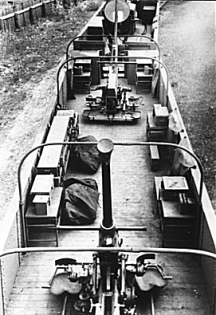
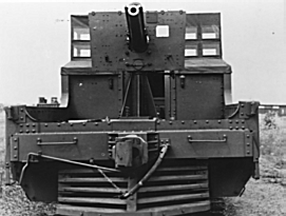
The Japanese departure from Kiska in the Aleutian Islands
and the reoccupation of the Island by the US Army certainly lessened the
threat to Prince Rupert and the train was eventually taken out of service.
The train was parked on the siding at Terrace and eventually returned to
the CNR for dismantling., a little over two years since its creation.
Ted refers to an excellent book on the topic; THE ARMOURED
TRAIN IN CANADIAN SEVICE by Roger V. Lucy. Your Editor was able to obtain
this book, courtesy of Robert Henderson. Following are some interesting
excerpts from Roger Lucy’s book.
With the attack on Pearl Harbour December 7, 1941 and
the fall of Singapore 15 February 1942, public opinion on the West Coast,
in the words of C.P. Stacey were ….in a state approaching panic…..
[Editor – at that time plans for the mass evacuation
of Vancouver Island where being formulated.] Security was so
tight that people in Prince Rupert did not know of the armoured train until
after the war.
The CNR train crew consisted of, engineer, fireman, conductor,
and two brakemen. Department of National Defence reimbursed the CNR $100.00
per day for each crew member and $80.00 per day for rental of equipment.
The train at all times was to be in charge of the CNR
crew, who in turn were under the orders of the O.C. Troops and move the
train in accordance to his instructions subject to the standard of operating
rules.
The five officers and 145 Other Ranks were made up mainly
of Home Defence conscripts and moral was not high. Major General
W.A. Giesbach , Inspector General for Western Canada states that he found
them unenthusiastic, even sullen. On the first run to Prince Rupert two
went AWOL.
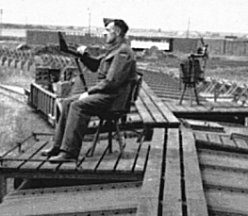
And you tail gunners thought you had it tough.
To add to the problems the rail bed was in need of up
grading. Ties were rotting and some spikes were so loose they could be
removed by hand. The resulting vibration necessitated lowering the speed
to 10 to 15 mph. The vibrations played havoc with the search lights and
gun mountings which were attached solidly to the floors of the rail cars.
The cars had to be sent to Vancouver for adjustments.
For security reasons the train did not adhere to scheduled
runs. As a result it ran over a man asleep on the tracks severing both
is legs. It was determined that he was a local sleeping off a binge.
Two CNR rail line workers were killed when the train hit them when they
were using jackhammers. Due to the non scheduled runs they were not expecting
the train and they did not hear it approaching over the sound of
jackhammers .Due to the status of the roadbed, the train was located at
Tyee, close to the mouth of the Skeena.
On November 7, 1942 the train complement consisted of
a Major, Company Sgt. Major, Quarter Master Sergeant, 3 Corporals,, clerk,
artificer, and cook. The remainder of the crew were detailed from 14th
Brigade, an Infantry company (5 officers and 119 Ors) gun crew (2 officers
and 24Ors, searchlight crew (8 Ors), signals (3Ors), Medical staff,
and 3 Royal Canadian Engineers.
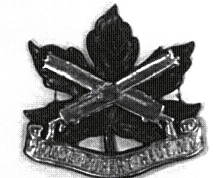
Prince Rupert Regiment Badge provided by
stamp and Military Memorabilia Collector
Nick Kainer, Regina, SK.
Nick served with 5th Canadian Armoured Troop W/S
in the Italian Campaign.
The first Commanding Officer of the Armoured train was
Captain N..K. Gateson of the Winnipeg Grenadiers who served from 27 June,
1942 to 28 February 1943. He was replaced by Major J.C. Herbert of the
Oxford Rifles who served until the train was moth-balled in October 1943.

On July 31, 1944, Royal Assent was given to the Order
in council disbanding the Unit.
Ted suggested your Editor add a line concerning the North
West Coast defences. [Big mistake Ted, never ask a yakkety old bugger
to “add a line.”]
In 1942 we had to challenge all shipping in the area with
the call signals of the day. We often came across Russian freighters heading
for the port of Prince Rupert. Sometimes they would respond, sometimes
not. When we dropped down to deck level their ack ack guns followed us
closely. In most cases they were manned by women. We went down to the docks
when they arrived in port but they were forbidden to speak with us.
My experience with the mighty Skeena is as follows.
The Diversion Base
Jerry Mckenna and I were returning from a patrol and base
radioed advising that Prince Rupert was fogged in. We were ordered to divert
to the Diversion Base at Lake Lac Else, approximately 60 miles inland up
the Skeena River, We found the mouth of the river but, due to heavy fog,
Jerry had to fly with the pontoons just above the fast flowing river waters.
We had to follow the river under fog banks and around
many bends. At each turn in the river we prayed the fog around the corner
would not be completely down on the deck. Mountains rose steeply on either
side, and many power lines crossed the river. We flew under the lines.
Finally we reached the camp and landed on the fresh water
lake. The camp consisted of a one-room log cabin, no water or power, many
45 gallon drums of aviation fuel, piles of firewood. The one room cabin
had a table, chairs, three beds, a wood stove, dishes and cutlery, and
a cupboard full of canned goods covered in mould and rotting labels. They
were all pork and beans. There were no personnel in attendance. The place
was overgrown with weeds and bush and had become home to squirrels, whiskey
jacks, and black bears
Each morning we would start the aircraft engine, and radio
base for instructions. Due to the bad weather on the coast we spent three
days at the lake with nothing to eat but pork and beans, and no local stores
to purchase food. It was a pleasure swimming in the fresh water lake.
On return to Prince Rupert we learned that the Diversion
Base was a precaution in the event of an enemy attack. Our obsolete aircraft
would be no match for enemy fighters, so the plan was to move the whole
squadron inland. Ottawa realized the inadequacy of its West Coast defences.
We never saw or heard of the armoured train.
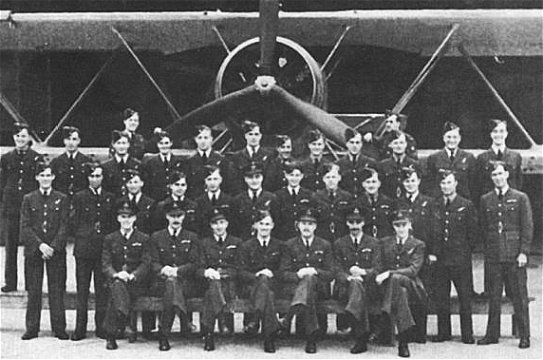
7 BR Squadron, February 1942 (minus two crews on patrol)
Jerry Mckenna 2nd row 6 from Right. Jerry was killed
in action flying out of Iceland with 162 Squadron, at the age of 22.
We will remember him.
John Moyles (age 19) back row 2nd from Left. Other
Members of the Ex-AG’s Association: Paul Switzer, Abbottsford, BC., back
row 4th from Right ~ Mel Livingstone, Vancouver, BC., back row 3rd from
Right ~ Tommy Taylor, Mather, Man., back row 5th. From Right; Harold Penn,
Burlington, Ont., Left Prop Blade. Behind, the mighty Blackburn Shark.
Ted Hackett sent the following bit of trivia
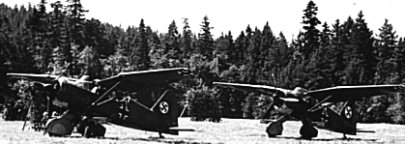
RCAF Station Patricia Bay, BC 1942
Two RCAF Westland Lysanders painted to look like Lufwaffe
aircraft for the movie, Commandos
Strike at Dawn.
Starring, paul Muni, Ana Lee, Sir Cedric Hardwicke, Robert
Coote, and Rosemary DeCamp.
Feedback
from Fairey Battle articles in June Page
By Howard Elliot
I earned my Air Gunners Wing at # 3 B&G Macdonald
MB.
The Day that my lower bunk mate Bill Elliott (from Montreal,
Que) and myself (from Melville, Sk) did our drogue firing exercise,
from a Fairey Battle, it was in January and the temp. was minus 30 degrees
F. Bill was allotted to fire his rounds first, so I vividly remember
the square "hole" in the floor of the fuselage with no hatch cover.
What a smell of exhaust, glycol, fuel and oil. I was sick to my stomach
and barfed several times. The first time it was so sudden,
my lunch went everywhere inside the plane. I managed to get
further upheavals out the "hole", without falling out, despite the fact
there was no safety device to keep us from falling out.
I told Bill to fire off my rounds, which he did.
Perhaps the extra practise got him through his tour of "ops". When
we landed, I could hardly stand and was ordered to see the M.O. I
spent the night under observation and was informed another
incident like that and I would be out of aircrew. I was never airsick again.
Man was I embarrassed, poor Bill had to clean up the mess. We realized
the NCO only had one Elliott on his list at inspection time. Thus
we would take turns missing parade.
I had my first flight, in Melville, when I was about 15.
In Melville, on Dominion Day, the movie projectionist Harry Card, would
give the public a flip for a dollar per pound, if one weighed over one
hundred pounds. If one weighed less than a hundred pounds, it was
a dollar. I made 4 quarters by playing the only song I knew on the
piano. F/L Card was attached to # 30 Hurricane Sqdn and died 29 Dec
l940.
P.S. When I was in Britain, I was fortunate
to get leave and went to Ireland. With help from the Legion, I was
able to locate and visit 3rd cousin Elliotts, in the area of Donegal, which
I have kept in touch with. Unfortunately with the pressures of re-entering
civy life, I did not keep up with Bill Elliott, who knows we might have
been related.
God bless, take care. Howard
CORRESPONDENCE
Hi,
I am a cousin of Harold Constable, born Windsor, Ontario,
1922. Harold flew in Lancasters from the Diss area U.K. 1944 -1945.
I do know from earlier enquiries that Harold passed away
some eight years ago in Windsor but I am trying to trace his Squadron number
information whilst in the U.K. and details of when he was shot down over
Holland 1944 or 1945.
Any further information would be gratefully received for
family history records.
Regards John Constable (Ex F.A.A)
john-constable@lineone.net
Dear John Moyles,
I've arrived at " Short bursts " after quite some time
of trawling the net. I have a friend and neighbour, Walter Booth, who flew
with the RCAF as radio op out of Croft during WW2.
As with most lads who served, I wasn't aware of this fact
until quite recently because he never spoke of it. It was only when I told
him last year I was visiting my brother in Ontario that it all came out.
Now to the point. I agreed to search for any information
I could find on 434 Sqdn and more especially the crew he flew with. Some
was plain sailing due to so much effort by people like yourself, but other
bits ( Up-to-date information on the crew ) I've hit a blank wall and don't
know where to turn. If you have time, could you please tell me where to
look or who to contact ? If he had been with an RAF crew I think this would
have been so much easier. I have joined so many British forums and drawn
a blank !
Just to let you know this is in fact a genuine search
the crew were -
434 sqdrn, crew 170.
F/L D.A.Milloy ( pilot ) RCAF
Sgt. G.C.Cook ( navigator ) RCAF
F/O A.Tschaikowsky ( bomb aimer ) RCAF
Sgt. A.Macarthur ( mid upper gunner ) RCAF
Sgt A.Dunne ( tail gunner ) RCAF
F/S F.Newton ( flight engineer ) RAF
And Sgt Walter Booth 2204667 ( radio opp ) RAF
I have been told that to get information on the dead or
missing is quite easy. The living are so much more difficult. I agree.
Thanks for your time,
Dave Williams.
Dear Sir,
Possibly it's a bit after the fact but I located the link
shown below wherein Adrian was looking for photographs of the RAF Memorial
at Alness. My wife and I visited Alness/Invergordon in May this year and
a very kind gentleman from the Alness Heritage Society drove us to the
memorial and around many of the sites where WW2 remnants were still in
place that a tourist from Canada would never have found.
Adrian had requested photographs of the memorial and since
the link to his e-mail address has been disabled I have attached them here
for forwarding to him if possible. If he wishes to contact me directly,
he may reply to this e-mail address or moosepasture@shaw.ca.
There is a memorial room in the Heritage Society’s house dedicated to the
air force during those times and they have a number if interesting artifacts
and are constantly trying to acquire additional information.
I took quite a few digital photographs during our visit
and would be pleased to share them with any interested person.
My father was a WAG on Sunderlands flying out of Alness
on August 15, 1944. He and 10 other young Canadian airmen were killed on
November 26th when DD851 crashed and burned with a full load of fuel and
depth charges on the railway tracks two miles northeast of the Invergordon
railway station. The funeral parade would obviously have been a few days
later. All except one of the crew were buried in the Roskeen Cemetery.
The photographs are of the Memorial to the men who served
at RAF Alness. It was unveiled by John Cruickshank, V.C. on October 16,
2001.
Kindest regards,
David Kinton
